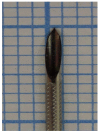Technical tips of endoscopic ultrasound-guided choledochoduodenostomy
- PMID: 25624715
- PMCID: PMC4299334
- DOI: 10.3748/wjg.v21.i3.820
Technical tips of endoscopic ultrasound-guided choledochoduodenostomy
Abstract
Endoscopic ultrasound (EUS) is clinically useful not only as a diagnostic tool during EUS-guided fine needle aspiration, but also during interventional EUS. EUS-guided biliary drainage has been developed and performed by experienced endoscopists. EUS-guided choledocoduodenostomy (EUS-CDS) is relatively well established as an alternative biliary drainage method for biliary decompression in patients with biliary obstruction. The reported technical success rate of EUS-CDS ranges from 50% to 100%, and the clinical success rate ranges from 92% to 100%. Further, the over-all technical success rate was 93%, and clinical success rate was 98%. Based on the currently available literature, the overall adverse event rate for EUS-CDS is 16%. The data on the cumulative technical and clinical success rate for EUS-CDS is promising. However, EUS-CDS can still lead to several problems, so techniques or devices that are more feasible and safe need to be established. EUS-CDS has the potential to become a first-line biliary drainage procedure, although standardizing the technique in multicenter clinical trials and comparisons with endoscopic biliary drainage by randomized clinical trials are still needed.
Keywords: Endoscopic ultrasound; Endoscopic ultrasound-guided biliary drainage; Endoscopic ultrasound-guided choledochoduodenostomy; Percutaneous transhepatic biliary drainage.
Figures






Similar articles
-
Endoscopic ultrasonography-guided biliary drainage: Who, when, which, and how?World J Gastroenterol. 2016 Jan 21;22(3):1297-303. doi: 10.3748/wjg.v22.i3.1297. World J Gastroenterol. 2016. PMID: 26811666 Free PMC article. Review.
-
Feasibility and safety of using Soehendra stent retriever as a new technique for biliary access in endoscopic ultrasound-guided biliary drainage.World J Gastroenterol. 2015 Mar 7;21(9):2725-30. doi: 10.3748/wjg.v21.i9.2725. World J Gastroenterol. 2015. PMID: 25759542 Free PMC article.
-
Endoscopic ultrasound-guided choledochoduodenostomy for malignant lower biliary tract obstruction.Gastrointest Endosc Clin N Am. 2012 Apr;22(2):259-69, ix. doi: 10.1016/j.giec.2012.04.008. Epub 2012 May 3. Gastrointest Endosc Clin N Am. 2012. PMID: 22632948 Review.
-
Technical tips for endoscopic ultrasound-guided hepaticogastrostomy.World J Gastroenterol. 2016 Apr 21;22(15):3945-51. doi: 10.3748/wjg.v22.i15.3945. World J Gastroenterol. 2016. PMID: 27099437 Free PMC article. Review.
-
Endoscopic Ultrasound-Guided Biliary Drainage of First Intent With a Lumen-Apposing Metal Stent vs Endoscopic Retrograde Cholangiopancreatography in Malignant Distal Biliary Obstruction: A Multicenter Randomized Controlled Study (ELEMENT Trial).Gastroenterology. 2023 Nov;165(5):1249-1261.e5. doi: 10.1053/j.gastro.2023.07.024. Epub 2023 Aug 6. Gastroenterology. 2023. PMID: 37549753 Clinical Trial.
Cited by
-
EUS-Guided Antegrade Biliary Stenting Using a Novel Fully Covered Metal Stent (with Video).J Gastrointest Surg. 2019 Jan;23(1):192-198. doi: 10.1007/s11605-018-3914-7. Epub 2018 Aug 20. J Gastrointest Surg. 2019. PMID: 30128830
-
Endoscopic Ultrasound-Guided Choledochoduodenostomy as Palliative Treatment: A Challenging Case Report.GE Port J Gastroenterol. 2018 Apr;25(3):146-150. doi: 10.1159/000481175. Epub 2017 Oct 11. GE Port J Gastroenterol. 2018. PMID: 29761151 Free PMC article.
-
Current paradigm of endoscopic ultrasound in biliary and pancreatic duct drainage: an update.Ann Gastroenterol. 2024 Jan-Feb;37(1):1-14. doi: 10.20524/aog.2023.0854. Epub 2024 Dec 23. Ann Gastroenterol. 2024. PMID: 38223246 Free PMC article. Review.
-
Reality named endoscopic ultrasound biliary drainage.World J Gastrointest Endosc. 2015 Oct 25;7(15):1181-5. doi: 10.4253/wjge.v7.i15.1181. World J Gastrointest Endosc. 2015. PMID: 26504507 Free PMC article. Review.
-
Endoscopic ultrasonography-guided biliary drainage: Who, when, which, and how?World J Gastroenterol. 2016 Jan 21;22(3):1297-303. doi: 10.3748/wjg.v22.i3.1297. World J Gastroenterol. 2016. PMID: 26811666 Free PMC article. Review.
References
-
- Fogel EL, Sherman S, Devereaux BM, Lehman GA. Therapeutic biliary endoscopy. Endoscopy. 2001;33:31–38. - PubMed
-
- Williams EJ, Taylor S, Fairclough P, Hamlyn A, Logan RF, Martin D, Riley SA, Veitch P, Wilkinson M, Williamson PJ, et al. Are we meeting the standards set for endoscopy? Results of a large-scale prospective survey of endoscopic retrograde cholangio-pancreatograph practice. Gut. 2007;56:821–829. - PMC - PubMed
-
- Oh HC, Lee SK, Lee TY, Kwon S, Lee SS, Seo DW, Kim MH. Analysis of percutaneous transhepatic cholangioscopy-related complications and the risk factors for those complications. Endoscopy. 2007;39:731–736. - PubMed
-
- Winick AB, Waybill PN, Venbrux AC. Complications of percutaneous transhepatic biliary interventions. Tech Vasc Interv Radiol. 2001;4:200–206. - PubMed
-
- Carrasco CH, Zornoza J, Bechtel WJ. Malignant biliary obstruction: complications of percutaneous biliary drainage. Radiology. 1984;152:343–346. - PubMed
Publication types
MeSH terms
LinkOut - more resources
Full Text Sources
Other Literature Sources

